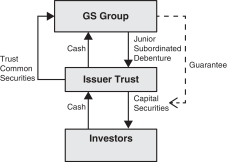Free signup for more
- Track your favorite companies
- Receive email alerts for new filings
- Personalized dashboard of news and more
- Access all data and search results
Filing tables
Filing exhibits
- S-3ASR Automatic shelf registration
- 1.3 Form of A&r Distribution Agreement, Series N
- 1.6 Form of Underwriting Agreement - Debt Securities
- 1.7 Form of Underwriting Agreement - Subordinated Debt Securities
- 1.11 Form of Underwriting Agreement - Preferred Stock
- 1.14 Form of A&r Distribution Agreement, Series E
- 1.15 Form of Distribution Agreement, Series F
- 4.31 Amend. No. 1 to Deposit Agreement
- 4.37 Form of Floating Rate SR. Debt Security
- 4.39 Form of Fixed Rate SR. Debt Security
- 4.40 Form of Fixed/floating SR. Debt Security
- 4.41 Form of Subordinated Debt Security
- 4.44 Form of Floating Rate Medium-term Note, Series N
- 4.47 Form of Fixed Rate Medium-term Note, Series N
- 4.57 Specimen Master Note, MTN Series N
- 4.69 7TH Supplemental Indenture (GSFC SR. Debt Indenture, October 10, 2008)
- 4.75 Form of Floating Rate Medium-term Note, Series E
- 4.76 Form of Floating Rate Medium-term Note, Series F
- 4.78 Form of Fixed Rate Medium-term Note, Series E
- 4.79 Form of Fixed Rate Medium-term Note, Series F
- 4.81 Form of Index-linked Medium-term Note, Series E
- 4.82 Form of Index-linked Medium-term Note, Series F
- 4.83 Specimen Master Note No. 3, MTN Series E
- 4.84 Specimen Master Note No. 4, MTN Series E
- 4.85 Specimen Master Note No 1, MTN Series F
- 4.86 Specimen Master Note No. 2, MTN Series F
- 5.1 Opinion of Richards Layton & Finger P.a. Re Goldman Sachs Capital VI and VII
- 5.2 Opinion of Sullivan & Cromwell LLP Re Omnibus
- 5.3 Opinion of Sullivan & Cromwell LLP Re Guarantees of Specified CDS
- 5.4 Opinion of Sullivan & Cromwell LLP Re Guarantees of Notes and Deposit Notes
- 5.5 Opinion of Sidley Austin LLP Re Debt Securities of GS Group
- 5.6 Opinion of Sidley Austin LLP Re Debt Securities of GSFC
- 8.1 Tax Opinion of Sullivan & Cromwell LLP
- 8.2 Tax Opinion of Sidley Austin LLP
- 8.3 Tax Opinion of Sidley Austin LLP Re GSFC
- 15.1 Letter Re Unaudited Interim Financial Information
- 23.1 Consent of Independent Registered Public Account Firm
- 25.1 Statement of Eligibility - GSG 1999 Indenture
- 25.2 Statement of Eligibility - GSG 2008 Indenture
- 25.3 Statement of Eligibility - GSG 2004 Sub Debt Indenture
- 25.4 Statement of Eligibility - Warrant Indenture
- 25.5 Statement of Eligibility - GS Cap 1 Trust Agreement
- 25.6 Statement of Eligibility - GS Cap 1V Trust Agreement
- 25.7 Statement of Eligibility - GS Cap V Trust Agreement
- 25.8 Statement of Eligibility - GS Cap V1 Trust Agreement
- 25.9 Statement of Eligibility - GS Cap VI1 Trust Agreement
- 25.10 Statement of Eligibility - GS Cap 1 Guarantee
- 25.11 Statement of Eligibility - GS Cap 1I Guarantee
- 25.12 Statement of Eligibility - GS Cap III Guarantee
- 25.13 Statement of Eligibility - GS Cap VI Guarantee
- 25.14 Statement of Eligibility - GS Cap VI1 Guarantee
- 25.15 Statement of Eligibility - GSFC 2007 Indenture
- 25.16 Statement of Eligibility - GSFC 2008 Indenture
Associated filings
- 18 Feb 21 POSASR Automatic shelf registration (post-effective amendment)
- 2 Jul 20 424B3 Prospectus supplement
-
1 Jul 20 S-3ASR Automatic shelf registration
Goldman Sachs Capital VI similar filings
Filing view
External links






